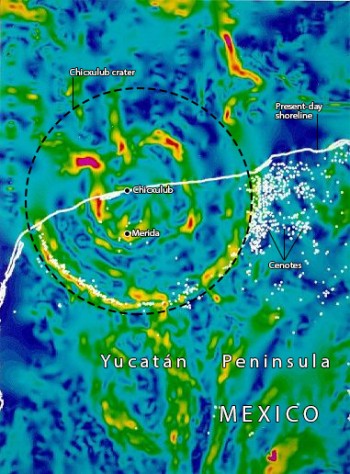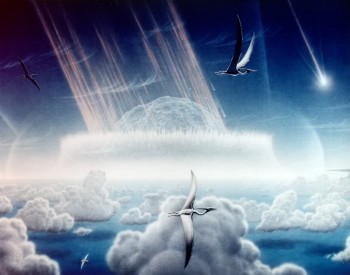Expedition Will Sample Crater Left By Dinosaur-Killing Asteroid
April 6, 2015

An international research team is formalizing plans to drill nearly 5,000 feet below the seabed to take core samples from the crater of the asteroid that wiped out the dinosaurs.
The group met last week in Merida, Mexico, a city within the nearly 125-mile-wide impact site, to explain the research plans and put out a call for scientists to join the expedition planned for spring 2016. The roughly $10 million in funding for the expedition has been approved and scheduled by the European Consortium for Ocean Research Drilling (ECORD) — part of the International Ocean Discovery Program (IODP) — and the International Continental Scientific Drilling Program (ICDP).
Dinosaurs and other reptiles ruled the planet for 135 million years. That all changed 65 million years ago when a 9-mile-wide asteroid slammed into the Earth, triggering a series of apocalyptic events that killed most large animals and plants, and wiped out the dinosaurs and large marine reptiles. The event set the stage for mammals — and eventually humans — to take over. Yet, we have few geologic samples of the now buried impact crater.
Sean Gulick, a researcher at The University of Texas at Austin Institute for Geophysics (UTIG), and a team of scientists from the U.K. and Mexico are working to change that. The team is planning to take the first offshore core samples from near the center of the impact crater, which is called Chicxulub after the seaside village on the Yucatán Peninsula near the crater’s center.
The team, led by Gulick and Joanna Morgan of Imperial College London, will be sampling the crater’s “peak ring” — an enigmatic ring of topographically elevated rocks that surrounds the crater’s center, rises above its floor and has been buried during the past 65 million years by sediments.
A peak ring is a feature that is present in all craters caused by large impacts on rocky planetoids. By sampling the Chicxulub peak ring and analyzing its key features, researchers hope to uncover the impact details that set in motion one of the planet’s most profound extinctions, while also shedding light on the mechanisms of large impacts on Earth and on other rocky planets.
“What are the peaks made of? And what can they tell us about the fundamental processes of impacts, which is this dominant planetary resurfacing phenomena?” said Gulick, who is also a research associate professor at the UT Jackson School of Geosciences. UTIG is a research unit of the Jackson School.

The researchers are also interested in examining traces of life that may have lived inside the peak ring’s rocks. Density readings of the rocks indicate that they probably are heavily broken and porous — features that may have served as protected microenvironments for exotic life that could have thrived in the hot, chemically enriched environment of the crater site after impact. Additionally, the earliest recovery of marine life should be recorded within the sediments that filled in the crater in the millions of years after the impact.
“The sediments that filled in the [crater] should have the record for organisms living on the sea floor and in the water that were there for the first recovery after the mass extinction event,” Gulick said. “The hope is we can watch life come back.”
The expedition will last for two months and involve penetrating nearly 5,000 feet beneath the seabed from an offshore platform. The core will be the first complete sample of the rock layers from near the crater’s center.
Once extracted, the core will be shipped to Germany and split in two. Half will be immediately analyzed by an international team of scientists from the U.S., U.K., Mexico and other nations, and half will be saved at a core repository at Texas A&M University for future research needs by the international community.
The team also includes researchers from the National Autonomous University of Mexico (UNAM) and Centro de Investigación Científica de Yucatán (CICY). Scientists interested in joining the mission must apply by May 8, 2015. For more information on the mission and the application process, see the European Consortium for Ocean Research Drilling’s call for applications.
For more information contact: Anton Caputo, UT Jackson School of Geosciences communications director, 512-232-9623; or Monica Kortsha, UT Jackson School of Geosciences public affairs officer, 512-471-2241.
